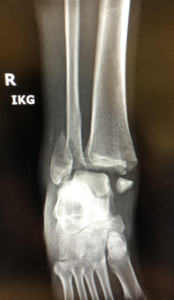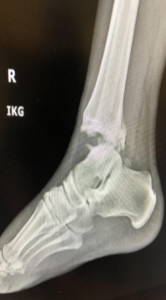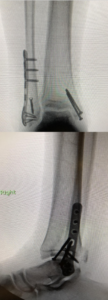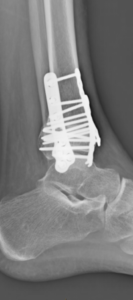Broken Ankle
What is a Broken Ankle?
A broken ankle or fractured ankle involves a break to one or more bones that make up the ankle joint. There is a huge spectrum of injury from those that are very minor and need no treatment to those which require multiple surgeries. The ankle is made up of three bones: the tibia, the fibula and the talus. Any of these bones can break in a variety of different ways. In general, the more bones that are broken and the farther apart the pieces are, the more serious the injury. These fractures are described according to where and how the bones break. Fractures of one bone include lateral malleolus fractures, medical malleolus fractures and posterior malleolus fractures. Breaks of multiple bones are described by how many bones are broken such as bimalleolar or trimalleolar fractures. Extremely high energy injuries fall into a class by themselves and are called tibial pilon fractures.
What Does the Ankle do?
The ankle is an important structure that provides support and stability for walking and standing. It has two major joints: the ankle joint and the syndesmosis. Both of these can be injured when the bones around them break. The inside of the ankle is called the medial malleolus. The back of the tibia is called the posterior malleolus and the end of the fibula is called the lateral malleolus. These joints are covered in cartilage which helps them move smoothly and without pain. Trauma to the joints or irregular healing can result in arthritis.
How is a Broken Ankle Diagnosed?
A broken ankle is diagnosed by a physical examination and in some cases, x-rays may be needed. Physical examination is critical in the evaluation of these injuries. Both bones and ligaments can be injured and physical exam can help determine treatment. Unstable injuries likely need surgery while stable injuries heal well with nonoperative care.
During the exam, the doctor will look for signs and symptoms of any open wounds over the injury as these usually require surgery. Often, the bone tries to poke out of the skin or “tent.” If this is not corrected, the skin can die or the bone can eventually cut the skin. Some types of ankle injuries can swell a lot. This can create blisters in the skin called fracture blisters. These can be filled with blood or clear fluid. Both require 10-14 days of waiting for skin to heal before surgery can be performed.
Imaging Tests
- X-rays are used to evaluate the location and severity of the broken ankle. This helps doctors and patients make an informed decision on treatment. Often 3 x-rays are taken to show the injury pattern.
- Stress x-rays can be used to evaluate the syndesmosis.
- CT (Computed Tomography) scans are often ordered to help plan treatment and surgery if the bone is in many pieces.
- MRIs (Magnetic Resonance Imaging) may be ordered to evaluate the ligaments or cartilage of the ankle that do not show up on plain x-rays.

Preoperative x-ray of ankle fracture.

Preoperative x-ray of ankle fracture.
Does Broken Ankle Require Surgery?
Many ankle fractures do not need surgery for the bone to heal. Small breaks or those with good overall alignment often can be treated without an operation. Nonsurgical treatment is also recommended for adults with poor overall health, fragile or chronically infected skin and less active patients. Splints, casts, ankle braces and walking boots are all used to treat these injuries depending on the fracture type and patient characteristics. Some injuries even allow for immediate weight bearing.
Non-Surgical Treatment
If non-operative care is chosen, regular follow-up care for a physical exam and x-rays are important to ensure that the fracture stays in good position and heals appropriately. Cutting down or quitting smoking and tight blood sugar control if you are a diabetic is important for the healing process. One fall or continued lack of compliance with casting, bracing or early walking against medical advice can cause bones to move and result in the need for surgery.
Depending on health and injury pattern, this bone can take 3 months to heal without surgery. Physical therapy for ankle range of motion is started around 6 weeks if patients have residual stiffness.
Surgical Treatment
Surgeons may recommend an operation to fix a broken ankle if the pieces are displaced, if the bone sticks out of the skin, if skin is at risk for dying or if the bone is unstable due to the fracture type.
The broken ankle can be fixed with metal plates and screws. The number and configuration of these implants and the incisions used during surgery depends completely on the fracture type and pattern. Surgery usually takes 1 to 2 hours. Most patients are able to undergo same day surgery and not spend the night in a hospital.
External Fixation for Fractured Ankles
In cases where there is significant swelling, skin blistering severe injury to the muscles, nerves or arteries or there is significant contamination with dirt, rocks or grass from the injury, some patient require external fixation prior to definitive surgical treatment. This is an operation where metal pins are placed into the bone through small cuts and connected to bars to give some stability to the bone. After secondary operations to clean the wound or recovery of skin injuries, the external fixator can be removed and plates and screws can be placed.
It is important to choose your surgeon wisely. Extensive surgical experience can be helpful in achieving a good result and avoiding complications. Collectively, ROC orthopedic surgeons have performed more ankle operations than any practice in northern Nevada and take pride in outstanding surgical results.

Postoperative x-ray of ankle fracture repair.
Recovery Time After Broken Ankle Surgery
After surgery, patients are usually not allowed to bear weight for 6 weeks. Patients will need to use a walker or crutches. During this time period patients are protected in a cast or walking boot. If patients develop ankle stiffness physical therapy can be started at 6 weeks. In patients who required screw placement across the syndesmosis, some surgeons elect to remove these screws 10-12 weeks after the initial surgery.
Postoperative X-Ray of Broken Ankle
Broken Ankle Surgery Complications
Complications can occur after broken ankle surgery. Some of the most common risks and complications include:
- Infection is a common risk with any surgery. The risk is much bigger for larger and more contaminated traumatic wounds. A dose of antibiotics given prior to surgery helps to make this risk as small as possible.
- Injury to blood vessels or nerves can occur. This is reduced by having an experienced surgeon involved in your care.
- Some bones may not heal properly as a result of patient noncompliance, diabetes, or use of nicotine like smoking and chewing tobacco.
Other complications may arise from noncompliance with weight bearing restrictions, too much motion or falls that can result in the metal ripping out of the bone or the fracture separating.
Broken Ankle Surgery Recovery Time
Most people with ankle fractures do very well and return to prior activities and function. By six weeks, patients are extremely comfortable. They cannot be released to full activities such as manual labor.
In need of an orthopedic specialist? Schedule an appointment with one of our specialty-trained Trauma and Fracture doctors to talk through your options. Reno Orthopedic Clinic offers comprehensive treatment for a full range of traumatic injuries at multiple convenient locations in Reno, Sparks and Carson City.

